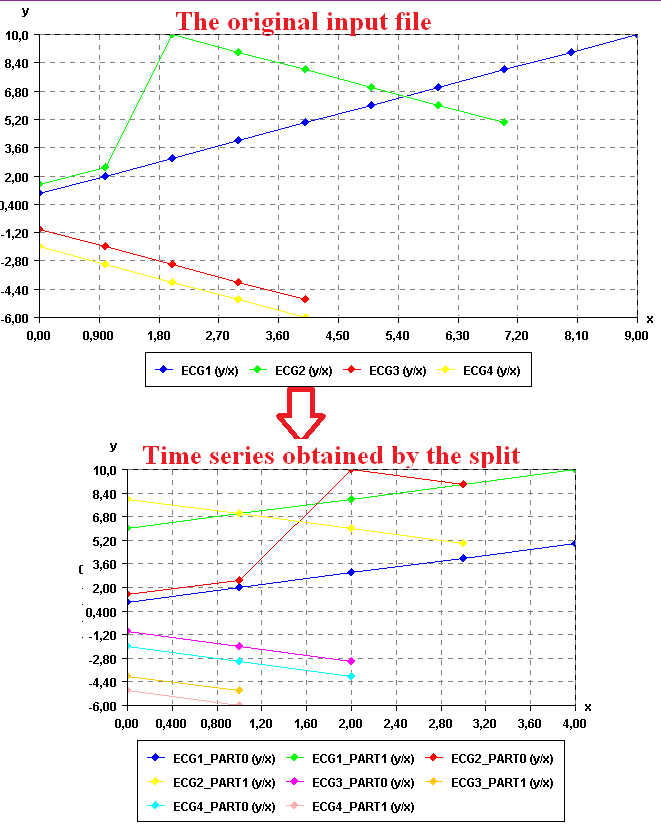Split time series by number of segments (SPMF documentation)
This example explains how to split a time series by number of segments using the SPMF open-source data mining library.
How to run this example?
- If you are using the graphical interface, (1) choose the "Split_time_series_by_number_of_segments" algorithm, (2) select the input file "contextSAX.txt", (3) set the separator to the comma ',' (4) set the number of segment to 2, and then (5) click "Run algorithm".
- If you want to execute this example from the command line,
then execute this command:
java -jar spmf.jar run Split_time_series_by_number_of_segments contextSAX.txt output.txt 2 ,
in a folder containing spmf.jar and the example input file contextSAX.txt. - If you are using the source code version of SPMF, to run respectively this example, launch the file "MainTestSplitTimeSeriesByNumberOfSegments_FileToFile.java"in the package ca.pfv.SPMF.tests.
What is this algorithm?
This algorithm takes one or more time series as input. Then it split each time series into several time series. The criteria for spliting the time series is a given number of segments specified by the user. If the user specify w segments, then each time series will be split into w time series. This simple algorithm is useful for spliting very long time series into several time series.
What is the input of this algorithm?
The input is one or more time series. A time series is a sequence of floating-point decimal numbers (double values). A time-series can also have a name (a string).
Time series are used in many applications. An example of time series is the price of a stock on the stock market over time. Another example is a sequence of temperature readings collected using sensors.
For this example, consider the four following time series:
| Name | Data points |
| ECG1 | 1,2,3,4,5,6,7,8,9,10 |
| ECG2 | 1.5,2.5,10,9,8,7,6,5 |
| ECG3 | -1,-2,-3,-4,-5 |
| ECG4 | -2.0,-3.0,-4.0,-5.0,-6.0 |
This example time series database is provided in the file contextSAX.txt of the SPMF distribution.
In SPMF, to read a time-series file, it is necessary to indicate the "separator", which is the character used to separate data points in the input file. In this example, the "separator" is the comma ',' symbol.
To split the data, it is required to provide a number of segments w per time series for spliting the time series.
What is the output?
The output is the set of time series that has been obtained by splitting each time series into w time series.
For example, in the above example, if the number of segments (data points) is set to 3 data points, the result is:
| Name | Data points |
| ECG1_PART0 | 1.0,2.0,3.0,4.0,5.0 |
| ECG1_PART1 | 6.0,7.0,8.0,9.0,10.0 |
| ECG2_PART0 | 1.5,2.5,10.0,9.0 |
| ECG2_PART1 | 8.0,7.0,6.0,5.0 |
| ECG3_PART0 | -1.0,-2.0,-3.0 |
| ECG3_PART1 | -4.0,-5.0 |
| ECG4_PART0 | -2.0,-3.0,-4.0 |
| ECG4_PART1 | -5.0,-6.0 |
To see the result visually, it is possible to use the SPMF time series viewer, described in another example of this documentation. Here is the result:

Input file format
The input file format used by this algorithm is efined as follows. It is a text file. The text file contains one or more time series. Each time series is represented by two lines in the input file. The first line contains the string "@NAME=" followed by the name of the time series. The second line is a list of data points, where data points are floating-point decimal numbers separated by a separator character (here the ',' symbol).
For example, for the previous example, the input file is defined as follows:
@NAME=ECG1
1,2,3,4,5,6,7,8,9,10
@NAME=ECG2
1.5,2.5,10,9,8,7,6,5
@NAME=ECG3
-1,-2,-3,-4,-5
@NAME=ECG4
-2.0,-3.0,-4.0,-5.0,-6.0
Consider the first two lines. It indicates that the first time series name is "ECG1" and that it consits of the data points: 1, 2, 3, 4, 5, 6, 7, 8, 9, and 10. Then, three other time series are provided in the same file, which follows the same format.
Output file format
The output file format is the same as the input format.
@NAME=ECG1_PART0
1.0,2.0,3.0,4.0,5.0
@NAME=ECG1_PART1
6.0,7.0,8.0,9.0,10.0
@NAME=ECG2_PART0
1.5,2.5,10.0,9.0
@NAME=ECG2_PART1
8.0,7.0,6.0,5.0
@NAME=ECG3_PART0
-1.0,-2.0,-3.0
@NAME=ECG3_PART1
-4.0,-5.0
@NAME=ECG4_PART0
-2.0,-3.0,-4.0
@NAME=ECG4_PART1
-5.0,-6.0